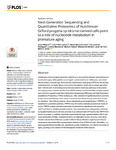Mostrar o rexistro simple do ítem
Next-Generation Sequencing and Quantitative Proteomics of Hutchinson-Gilford Progeria Syndrome-Derived Cells Point to a Role of Nucleotide Metabolism in Premature Aging
| dc.contributor.author | Mateos, Jesús | |
| dc.contributor.author | Fafián Labora, Juan Antonio | |
| dc.contributor.author | Morente-López, Miriam | |
| dc.contributor.author | Lesende-Rodríguez, Iván | |
| dc.contributor.author | Monserrat, Lorenzo | |
| dc.contributor.author | Ódena, María A. | |
| dc.contributor.author | Oliveira, Eliandre de | |
| dc.contributor.author | De-Toro, Javier | |
| dc.contributor.author | Arufe, M.C. | |
| dc.date.accessioned | 2018-11-14T08:53:28Z | |
| dc.date.available | 2018-11-14T08:53:28Z | |
| dc.date.issued | 2018-10-31 | |
| dc.identifier.citation | Mateos J, Fafián-Labora J, Morente-López M, Lesende-Rodríguez I, Monserrat L, Ódena MA, et al. Next-generation sequencing and quantitative proteomics of Hutchinson-Gilford progeria syndrome-derived cells point to a role of nucleotide metabolism in premature aging. PLoS ONE. 2018;13(10):e0205878 | es_ES |
| dc.identifier.issn | 1932-6203 | |
| dc.identifier.uri | http://hdl.handle.net/2183/21285 | |
| dc.description.abstract | [Abstract] Hutchinson-Gilford progeria syndrome (HGPS) is a very rare fatal disease characterized for accelerated aging. Although the causal agent, a point mutation in LMNA gene, was identified more than a decade ago, the molecular mechanisms underlying HGPS are still not fully understood and, currently, there is no cure for the patients, which die at a mean age of thirteen. With the aim of unraveling non-previously altered molecular pathways in the premature aging process, human cell lines from HGPS patients and from healthy parental controls were studied in parallel using Next-Generation Sequencing (RNAseq) and High-Resolution Quantitative Proteomics (iTRAQ) techniques. After selection of significant proteins and transcripts and crosschecking of the results a small set of protein/transcript pairs were chosen for validation. One of those proteins, ribose-phosphate pyrophosphokinase 1 (PRPS1), is essential for nucleotide synthesis. PRPS1 loss-of-function mutants present lower levels of purine. PRPS1 protein and transcript levels are detected as significantly decreased in HGPS cell lines vs. healthy parental controls. This modulation was orthogonally confirmed by targeted techniques in cell lines and also in an animal model of Progeria, the ZMPSTE24 knock-out mouse. In addition, functional experiments through supplementation with S-adenosyl-methionine (SAMe), a metabolite that is an alternative source of purine, were done. Results indicate that SAMe has a positive effect in the proliferative capacity and reduces senescence-associated Beta-galactosidase staining of the HPGS cell lines. Altogether, our data suggests that nucleotide and, specifically, purine-metabolism, are altered in premature aging, opening a new window for the therapeutic treatment of the disease. | es_ES |
| dc.language.iso | eng | es_ES |
| dc.publisher | PLOS | es_ES |
| dc.relation.uri | https://doi.org/10.1371/journal.pone.0205878 | es_ES |
| dc.rights | Atribución 3.0 España | es_ES |
| dc.rights.uri | http://creativecommons.org/licenses/by/3.0/es/ | * |
| dc.title | Next-Generation Sequencing and Quantitative Proteomics of Hutchinson-Gilford Progeria Syndrome-Derived Cells Point to a Role of Nucleotide Metabolism in Premature Aging | es_ES |
| dc.type | info:eu-repo/semantics/article | es_ES |
| dc.rights.access | info:eu-repo/semantics/openAccess | es_ES |
| UDC.journalTitle | PLOS one | es_ES |
| UDC.volume | 13 | es_ES |
| UDC.issue | 10 | es_ES |
| UDC.startPage | e0205878 | es_ES |
Ficheiros no ítem
Este ítem aparece na(s) seguinte(s) colección(s)
-
GI-TCMR - Artigos [123]
-
INIBIC-TCMR - Artigos [102]






